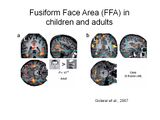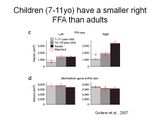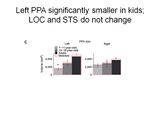2009 Alina Liberman
Back to Psych 204 Projects 2009
Category-Selective Regions in the Ventral Temporal Cortex
Background and Development
The ventral temporal cortex contains different regions that respond preferentially to faces more strongly than objects, objects more strongly than scrambled objects, and places more strongly than objects and faces.
The Fusiform Face Area (FFA) is a region in the occipitotemporal cortex (on the fusiform gyrus) that preferentially responds to visual face stimuli compared to place or object stimuli. It was first described as a module for face processing in Kanwisher et al. (1997). Since then, there has been a lot of debate about the properties of the FFA, including whether or not it processes other relevant and well-known objects.
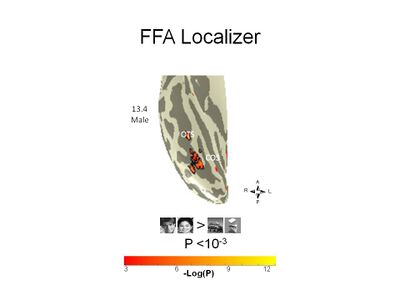
Golarai et al.(2007) found that the right FFA was significantly smaller in children (ages 7-11) than in adolescents (12-16) or adults (>18) (Figure 1 & 2). This size difference was not present for the right or left hemisphere face-selective superior temporal sulcus (STS) or object-selective lateral occipital complex area (LOC) (Figure 3). The left hemisphere place-selective parahippocampal place area (PPA) was also significantly smaller in children (Figure 3). These results support a region and category-specific development of high-level visual cortex for faces and places.
-
Figure 1
-
Figure 2
-
Figure 3
An ongoing follow-up study with a new set of subjects and stimuli replicates the right FFA results, except that we find a significantly smaller right FFA in adolescents ages 12-16. This result suggests that cortical development for face processing continues beyond childhood and into adolescence. What may account for this difference in results? In addition to slightly different stimuli, the original study had different analysis methods for their fMRI data. The original study had bigger voxels (3.75mm x 3.75mm vs. 3.125mm x 3.125mm in-plane resolution) and spatially smoothed the data using a 6mm full-width-half-maximum kernel. Scherf et al.(2007) also only found a differences in the magnitude of face-specific activation and extent of activation in the FFA as well as the posterior STS (unlike in Golarai et al.) in kids but not adolescents, but this study spatially normalized their data into Talairach space.
Research Questions
I have been working on the ongoing follow-up study to Golarai et al. (2007), mentioned above, in Kalanit Grill-Spector's lab in collaboration with Golijeh Golarai and Davie Yoon. Our analysis are done in native subject space using unsmoothed data, but some labs doing similar work use spatially normalized and smoothed data (and sometimes get different results, as mentioned above in Scherf et al.(2007)). I was curious if using two different analysis methods could result in different conclusions, so I asked the following questions:
- How would the current data, analyzed in native space and without spatial smoothing, change if it was spatially smoothed and normalized?
- Specifically, how would the group-map differ from the individual maps in terms of face-, place-, and object-selective ROI locations, response amplitudes, and sizes?
- Would there still be a significant age difference in the size of the right FFA between adolescents and adults?
fMRI Methods
mrVista Analysis (no smoothing or normalizing)
Subjects
Subjects were 14 healthy adolescents ages 12-16 (7 females) and 11 healthy adults ages 18-40 (6 females).
MR Acquisition
Data were obtained on a 3 Tesla whole-body GE Signa MRI scanner at the Lucas Center using a surface coil and a T2*-sensitive gradient echo spiral pulse across 32 slices spanning from the occipital lobe to the anterior temporal lobe. The slices were oriented perpendicular to the calcarine sulcus.
Stimuli
Images were projected onto a mirror mounted on the coil. The images consisted of gray-scale photographs of male children and adults, abstract objects, cars, indoor and outdoor scenes, and scrambled images. Each image was shown for 900 ms in 12 second blocks, and each image type was shown twice per run.
MR Analysis
The MR data was analyzed using MATLAB and mrVista software tools.
Pre-processing
Functional data was motion corrected and data were detrended with a temporal high-pass filter. We converted the raw time course into percent signal change by dividing the response ampitude at each TR by the mean amplitude during the blank periods. There was no spatial smoothing or normalizing.
The T1 anatomical scan was segmented for each subject in order to separate the gray and white matter. The inplane for the functional scan was aligned to the T1 anatomical, and all further processing was done using the T1 anatomical with voxels restricted to the gray matter.
GLM
We ran a General Linear Model (GLM) with each of the SPM2 HRF-convolved stimulus conditions as a predictor. For each condition, the BOLD response amplitudes were estimated from the beta coefficients from a GLM applied to the time course.
Functional ROI Creation
For each subject, the Fusiform Face Area was defined as voxels within the fusiform gyrus that had a significance of p<.001 for the contrast of (man and boy)>(cars and abstract objects). Place-selective and object-selective ROIs were also defined in each hemisphere. The Parahippocampal Place Area (PPA) was defined as (indoor and outdoor scenes)>(abstract objects and cars), and the object-selective OTS (occipitotemporal sulcus) ROI was defined as (abstract objects and cars)> (scrambled images).
SPM Analysis
Note: Given the current state of certain code, it was not possible to do an SPM analysis of surface-coil fMRI data. SPM was not able to sufficiently co-register the anatomical inplane to the functional scans because they did not cover the whole brain (only the occipital and temporal lobes). Without this alignment, it was not possible to do the rest of the analysis because the inplane is used for normalization to the template brain.
The localizer data described below was originally collected by members of the Wagner lab and kindly shared with me so that I could do an SPM analysis.
Subjects
Subjects were 11 healthy adults ages 18-27.
MR Acquisition
Data were obtained on a 3 Tesla whole-body GE Signa MRI scanner at the Lucas Center using an 8-channel head coil and a spiral pulse across 30 slices spanning the whole brain.
Stimuli
Images were projected onto a mirror mounted on the coil. The images consisted of gray-scale photographs of male and female adult faces and natural scenes.
MR Analysis
The MR data was analyzed using MATLAB and SPM8 software tools.
Pre-processing
Functional data was slice-time corrected, motion corrected and data were detrended with a temporal high-pass filter. Functional images were also realigned and coregistered to anatomical images. Each subject's anatomical images were normalized into a canonical MNI template, and these normalization parameters were also applied to the functional data.
GLM
The GLM included the HRF-convolved face and scene conditions as predictors. For the group analysis, a random-effects t-test was used to identify voxels for which the average of the two parameter estimates reliably differed from zero across subjects. Results were thresholded at p<.001
Functional ROI Creation
MarsBaR toolbox for SPM was used to define functional ROIs on group data. The Fusiform Face Area was defined as voxels in the fusiform gyrus that had a significance of p<.001 for the contrast of (faces)>(scenes).
Results
ROI sizes using mrVista
The right and left FFA size was measured for all the adolescents and adults and restricted to the gray matter. The right FFA was significantly smaller in the adolescents compared to the adults, but the left FFA was not significantly different between age groups.
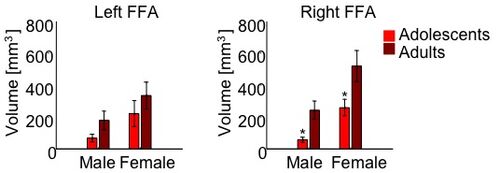
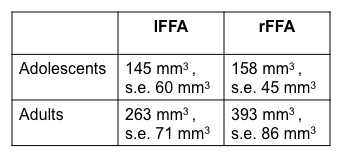
In order to see if other parts of the ventral stream were developing, the right and left place-selective PPA and object-selective OTS were also defined. Adolescents and adults had no significant size differences for these two areas, indicating a category-specific development for faces.
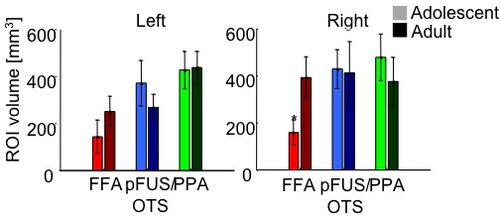
ROI sizes using SPM
Unfortunately, I was not able to do an analysis of the adolescents and adults used in the mrVista analysis as I had planned because the SPM coregistration code does not work very well for data that does not cover the whole brain. As I mentioned above, SPM was not able to sufficiently co-register the anatomical inplane to the functional scans. Labs using whole-brain data usually do not run into this problem with SPM.
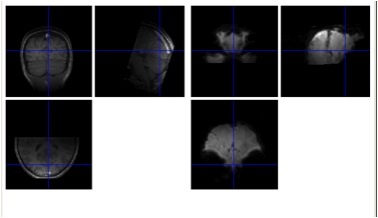
However, I was able to do an analysis of FFA size using adult localizer data with whole-brain coverage. I was able to do a cluster analysis on a right FFA using spatially normalized and smoothed group data. I was not able to get any whole-brain adolescent data as a comparison, so I just have right FFA size for the adults. As you can tell, the voxels in this data set have lower resolution and the right FFA size is about twice the average of the adults in the mrVista study.
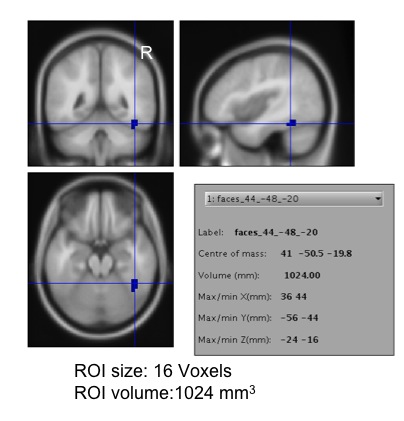
Conclusions
The mrVista analysis of adolescent and adult data showed that, on average, adults had significantly large right FFA sizes than adolescents. This effect was not present for the left FFA or for the left or right PPA or OTS ROIs. Since the FFA is thought to be specialized for face-processing, this indicates a category-specific developmental effect in the ventral stream. Face processing may be continuing to develop into adolescence, while object and place processing is already mature.
The SPM analysis showed that SPM does not work very well for high-resolution data with partial brain coverage because coregistration fails. However, an analysis of a separate data set showed that smoothed and spatially normalized group data will result in a very large right FFA, but the analysis was not sensitive enough to detect the presence of a left FFA. However, when using mrVista, almost every adult has both a right and left FFA.
References - Resources
References
Golarai G., Ghahremani D. G., Whitfield-Gabrieli S., Reiss A., Eberhardt J. L., Gabrieli J. D., Grill-Spector K. (2007). Differential development of high-level visual cortex correlates with category-specific recognition memory. Nat. Neurosci. 10, 512–522
Kanwisher N., McDermott J., Chun M. M. (1997). The fusiform face area: a module in human extrastriate cortex specialized for face perception. J. Neurosci. 17, 4302–4311
Scherf K. S., Behrmann M., Humphreys K., Luna B. (2007). Visual category-selectivity for faces, places and objects emerges along different developmental trajectories. Dev. Sci. 10, F15–F30 doi: 10.1111/j.1467-7687.2007.00595.x.
Software
mrVista: http://white.stanford.edu/software
SPM: http://www.fil.ion.ucl.ac.uk/spm
MarsBaR: http://marsbar.sourceforge.net/
